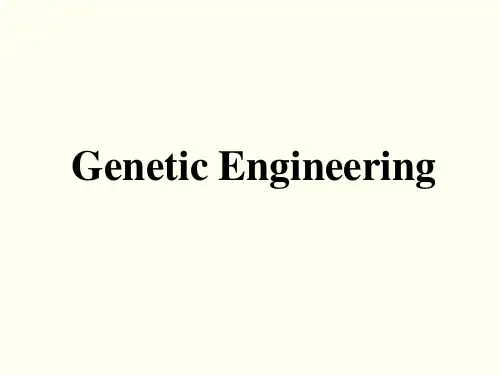分子生物学英文课件:Structure and Function of Proteins
- 格式:ppt
- 大小:19.15 MB
- 文档页数:236

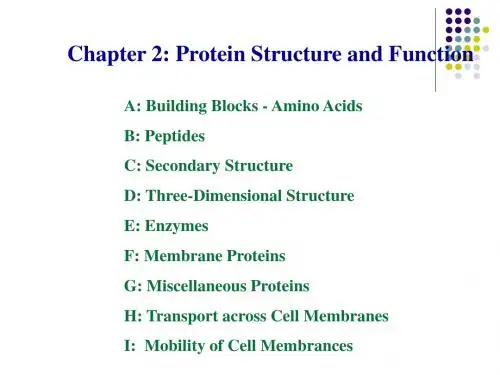

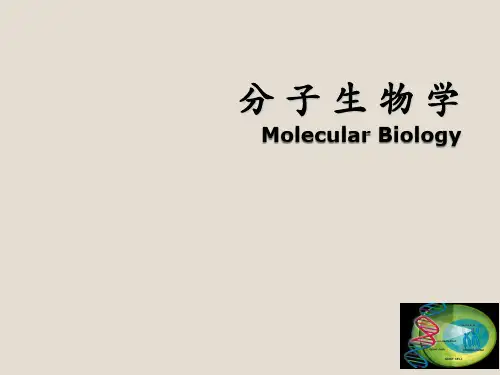
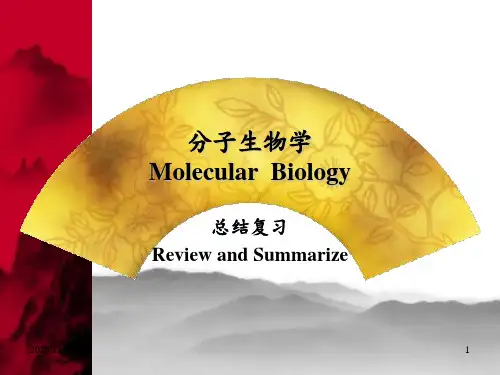
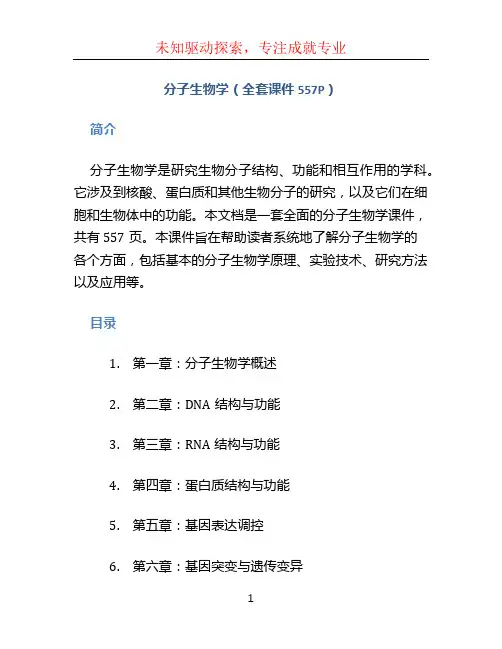
分子生物学(全套课件557P)简介分子生物学是研究生物分子结构、功能和相互作用的学科。
它涉及到核酸、蛋白质和其他生物分子的研究,以及它们在细胞和生物体中的功能。
本文档是一套全面的分子生物学课件,共有557页。
本课件旨在帮助读者系统地了解分子生物学的各个方面,包括基本的分子生物学原理、实验技术、研究方法以及应用等。
目录1.第一章:分子生物学概述2.第二章:DNA结构与功能3.第三章:RNA结构与功能4.第四章:蛋白质结构与功能5.第五章:基因表达调控6.第六章:基因突变与遗传变异7.第七章:分子生物学实验技术8.第八章:分子生物学研究方法9.第九章:分子生物学的应用领域第一章:分子生物学概述1.1 什么是分子生物学分子生物学是研究生物体内分子的结构、功能以及相互作用的学科。
它涉及到DNA、RNA、蛋白质等生物分子的研究,以及它们在细胞和生物体中的功能。
1.2 分子生物学的历史与发展分子生物学起源于20世纪50年代,当时发现DNA是物质遗传信息的携带者后,科学家们开始研究DNA的结构和功能,从而奠定了现代分子生物学的基础。
1.3 分子生物学的重要性分子生物学的研究对于了解生命的本质和机理至关重要。
它不仅有助于解释遗传现象,还可以揭示细胞的结构、功能和调控机制,甚至为疾病的诊断和治疗提供理论基础。
2.1 DNA的组成与结构DNA是由基因序列组成的生物分子,它由核苷酸组成。
本节将介绍DNA的基本结构、双螺旋结构和碱基对的配对方式。
2.2 DNA复制与遗传信息传递DNA复制是细胞分裂过程中最重要的事件之一,它确保了遗传信息的传递和稳定性。
本节将介绍DNA复制的过程和机制。
2.3 DNA修复与突变DNA在生物体内容易受到各种外界因素的损伤,因此细胞拥有多种修复机制来修复DNA损伤。
本节将介绍DNA修复的方式和维护基因组稳定性的重要性。
3.1 RNA的种类与功能RNA是DNA转录的产物,它在细胞内发挥着多种功能,包括mRNA的编码信息传递、tRNA的氨基酸运载和rRNA的构建核糖体等。

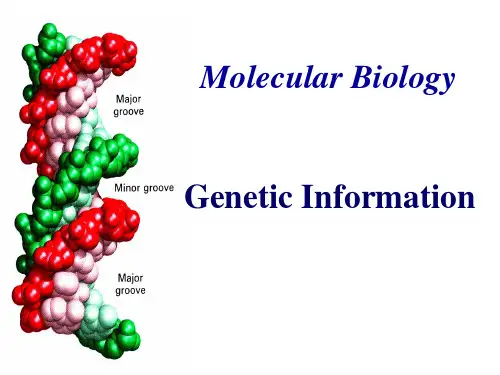
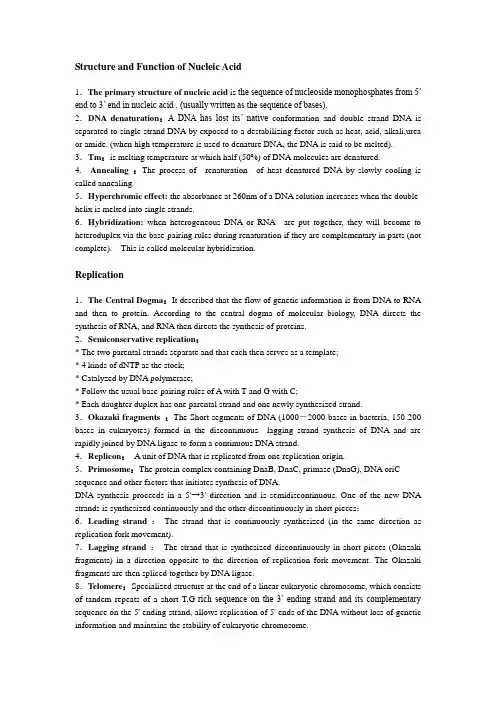
Structure and Function of Nucleic Acid1.The primary structure of nucleic acid is the sequence of nucleoside monophosphates from 5’ end to 3’ end in nucleic acid . (usually written as the sequence of bases).2.DNA denaturation:A DNA has lost its’ native conformation and double strand DNA is separated to single strand DNA by exposed to a destabilizing factor such as heat, acid, alkali,urea or amide. (when high temperature is used to denature DNA, the DNA is said to be melted). 3.Tm:is melting temperature at which half (50%) of DNA molecules are denatured.4. Annealing :The process of renaturation of heat denatured DNA by slowly cooling is called annealing.5.Hyperchromic effect: the absorbance at 260nm of a DNA solution increases when the double helix is melted into single strands.6.Hybridization: when heterogeneous DNA or RNA are put together, they will become to heteroduplex via the base-pairing rules during renaturation if they are complementary in parts (not complete). This is called molecular hybridization.Replication1.The Central Dogma:It described that the flow of genetic information is from DNA to RNA and then to protein. According to the central dogma of molecular biology, DNA directs the synthesis of RNA, and RNA then directs the synthesis of proteins.2.Semiconservative replication:* The two parental strands separate and that each then serves as a template;* 4 kinds of dNTP as the stock;* Catalyzed by DNA polymerase;* Follow the usual base-pairing rules of A with T and G with C;* Each daughter duplex has one parental strand and one newly synthesized strand.3.Okazaki fragments :The Short segments of DNA (1000-2000 bases in bacteria, 150-200 bases in eukaryotes) formed in the discontinuous lagging strand synthesis of DNA and are rapidly joined by DNA ligase to form a continuous DNA strand.4.Replicon:A unit of DNA that is replicated from one replication origin. 5.Primosome:The protein complex containing DnaB, DnaC, primase (DnaG), DNA oriC sequence and other factors that initiates synthesis of DNA.DNA synthesis proceeds in a 5'→3' direction and is semidiscontinuous. One of the new DNA strands is synthesized continuously and the other discontinuously in short pieces:6.Leading strand :The strand that is continuously synthesized (in the same direction as replication fork movement).7.Lagging strand:The strand that is synthesized discontinuously in short pieces (Okazaki fragments) in a direction opposite to the direction of replication fork movement. The Okazaki fragments are then spliced together by DNA ligase.8.Telomere:Specialized structure at the end of a linear eukaryotic chromosome, which consists of tandem repeats of a short T,G-rich sequence on the 3’ ending strand and its complementary sequence on the 5' ending strand, allows replication of 5' ends of the DNA without loss of genetic information and maintains the stability of eukaryotic chromosome.9.Telomerase:An RNA-containing reverse transcriptase that using the RNA as a template, adds nucleotides to the 3’ ending strand and thus prevents progressive shortening of eukaryotic linear DNA molecules during replication. Human telomerase contains three parts:Human telomerase RNA, hTRHuman telomerase associated protein 1, hTP1Human telomerase reverse transcriptase, hTRT10.Reverse Transcription:Synthesis of a double-strand DNA from an RNA template. 11.Reverse transcriptase:A DNA polymerase that uses RNA as its template.RNA-dependent DNA polymeraseRNaseDNA-dependent DNA polymeraseGene Recombination and Genetic Engineering1. DNA Cloning:To clone a piece of DNA, DNA is cut into fragments using restriction enzymes. The fragments are pasted into vectors that have been cut by restriction enzyme to form recombinant DNA. The recombinant DNA are needed to transfer and replicate DNA in a host cell.This serial process and related technique are called DNA cloning, also called gene cloning.2. Genomic DNA library:The collection of bacteria clones that contain all the DNA in the organism’s genome on vector of plasmids or bacteriophage.3. α-complementation:some plasmid vectors (eg,pUC19) carry lacZ gene, whose product αfragment is the N-terminal of the β-galactosidase. Whereas, the mutant E.coli strain only synthesize the ω fragment, which is the C-terminal of the enzyme. Eitherα or ω fragment alone is nonfunctional. When the vector containing lacZ is introduced into mutant E.coli, both theαand ωfragments are present. So there is an interaction and a functionally intact β-galactosidase can form. This interaction is called α- complementation.Regulation of Gene Expression1. Housekeeping gene: It is the genes coding for proteins that are needed for basic life processes in all kinds of cells(such as enzymes for citric acid cycle).2. Operon:consists of more than 2 coding sequences, promoter, operator and other regulatory sequences clustered in the genome.3. Promoter: It is the specific DNA sequence binding to RNA-pol to initiate transcription.4. Enhancer: consisting of several functional elements, apart from transcriptional initiation site, enhancing the activity of promoter, determining the stage and spatial specificity, functioning in different direction and distance on upstream or downstream。
